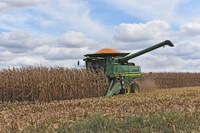NDSU provides guidance for North Dakota corn harvest and drying
(Click the image below to view a high-resolution image that can be downloaded)
Variability in moisture content and maturity of corn in the fields will impact harvest decisions this season, according to Ken Hellevang, North Dakota State University Extension agricultural engineer and grain drying expert.
“There is considerable variation this year due to the challenging spring, variation in rainfall, planting date, maturity rating and growing degree days, so it is important to check each field and even various areas in a field,” says Hellevang.
Normally, optimum harvest moisture content is about 20%. Moisture content greater than 20% increases drying cost and less than 20% increases harvest mechanical damage and field loss.
The amount of drying in the field depends on parameters such as corn maturity, hybrid, moisture content, air temperature, relative humidity, solar radiation and wind speed. The current forecast for October is slightly above normal temperatures and normal precipitation. Field drying normally is more economical until mid to late October in North Dakota, and mechanical high-temperature drying normally is more economical after that, Hellevang notes.
Natural-air and low-temperature drying using an airflow rate of at least 1.0 cubic feet of air per minute, per bushel are limited to an initial corn moisture content of about 20% to 21% and a corn depth of 20 to 22 feet. Even at that moisture content, air drying is limited in the northern states during the fall due to the colder outdoor temperatures in late October and November. Estimated drying time is about 40 days in October and 70 days in November. The moisture-holding capacity of air is very small at temperatures below about 40 degrees Fahrenheit. Expect to store the wet corn over winter by cooling it to between 20 and 30 degrees and drying in the spring when outside temperatures average above 40 degrees.
There are several types of dryers and options for high temperature corn drying. There are cross-flow dryers with and without corn turners and vacuum or heat reclaim cooling. There are also mixed-flow dryers and in-bin dryers. Each has specific features and benefits. Typical drying cost per point of moisture removed can be estimated by multiplying the propane cost per gallon by 0.02. For example, if propane is $2.00 per gallon, the propane cost for drying is about $0.04 per bushel per point of moisture removed.
Corn should be dried to about 15.5% moisture for storage over winter and about 13% to 14% if being stored into next summer. Cool the corn to between 20 and 25 degrees for winter storage. Hellevang supports using temperature cables to assist with monitoring the corn, but technology does not replace management. He still recommends monitoring the corn moisture content, inspecting for insects and observing the corn quality.
Remember safety when working around grain. Protect yourself from grain dust with an N95 mask. Do not go into a grain bin while the grain is moving. It only takes a couple seconds to become helpless in flowing grain. Use the lock-out tag-out system to assure that you do not get hurt while working on grain drying and handling equipment.
For more information on corn drying and storage, search online for NDSU grain drying and storage.
NDSU Agriculture Communication – Sept. 26, 2023
Source: Ken Hellevang, 701-231-7243, kenneth.hellevang@ndsu.edu
Editor: Elizabeth Cronin, 701-231-7881, elizabeth.cronin@ndsu.edu


